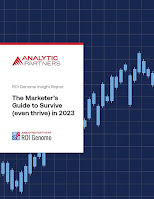 |
| Source: Analytic Partners |
Analytic Partners, a provider of marketing optimization solutions, recently published an ebook that offers marketers five recommendations for addressing the economic uncertainty that's likely to exist for much of 2023.
The Marketer's Guide to Survive (even thrive) in 2023 is based on insights derived from the firm's proprietary ROI Genome dataset, which contains millions of marketing and measurement metrics from 1,000+ brands in 50 countries.
Analytic Partners contends that economic uncertainty will be a prominent feature of the business landscape in 2023. The risk of a recession in the U.S. has risen as the Federal Reserve has increased interest rates and taken other steps to tighten financial conditions in an effort to combat inflation.
Even if a recession doesn't occur, fears of an economic downturn and the continuing effects of inflation may lead both consumers and business organizations to tighten their purse strings and put prospective purchases under greater scrutiny.
Here are Analytic Partners' five recommendations:
- "Hold your nerve: don't cut marketing spending"
- "Focusing only on performance messaging misses opportunities"
- "Exploit the power of brand marketing"
- "Measure everything (because everything counts)"
- "Use scenario planning to understand the total customer journey"
While all of these recommendations are valuable, the first three are particularly important when economic conditions turn sour. Let's take a closer look at those three.
Don't Cut Marketing Spending
The research by Analytic Partners found that 63% of brands that increased their investment in marketing after the "great financial crisis" of 2008 generated a positive ROI, and those that increased their media investments realized a 17% growth in incremental sales.
The idea that companies should maintain their marketing spending during an economic downturn isn't new. Numerous studies dating back to the early years of the last century have consistently shown that companies that maintain their spending on marketing during a slowdown outperform those that slash their marketing and advertising budgets.
One of the more recent studies was described in a
March 2010 article in the Harvard Business Review. The objective of this research was to identify the strategies that can "help companies survive a recession, get ahead during a slow-growth recovery, and be ready to win when good times return."
The study examined the strategies and performance of 4,700 public companies before, during, and after three pre-2008 global recessions. The researchers found that an optimal combination of offensive and defensive strategies gave companies the best chance of outperforming their peers (in terms of both sales and profit growth) after the recession. They summarized their core finding as follows:
"According to our research, companies that master the delicate balance between cutting costs to survive today and investing to grow tomorrow do well after a recession . . . These companies reduce costs selectively by focusing more on operational efficiency than their rivals do, even as they invest relatively comprehensively in the future by spending on marketing, R&D, and new assets."
Balance Brand and Performance Marketing
The second and third recommendations made by Analytic Partners relate to the importance of maintaining the right balance of brand and performance marketing even when economic conditions are difficult.
During an economic slowdown, business and marketing leaders tend to focus on activities that will produce quick wins. Because of this tendency, they will often shift marketing spending from upper funnel brand building programs to lower funnel performance marketing programs.
Analytic Partners argues that this is the wrong strategy to follow. Their ROI Genome data shows that brand messaging outperforms performance messaging 80% of the time. The data also shows that, overall, upper funnel brand marketing tactics are 60% more effective over the long term than lower funnel performance marketing tactics, and only 25% less effective in the short term.
The conclusion reached by Analytic Partners is stated in clear terms: "The evidence shows that channeling budget away from brand marketing to performance marketing is the wrong lever to pull. It will negatively impact both the short and long-term success of your business."
Given this view, Analytic Partners recommends that marketers, ". . . cap performance marketing spend at no more than 50% [of total marketing spend], so that at least half goes on brand and other upper funnel marketing activities."
The view advocated by Analytic Partners has been supported by other (relatively) recent research. In 2019,
The B2B Institute (a think tank funded by LinkedIn) published a research report dealing with B2B growth.
The 5 Principles of Growth in B2B Marketing described the findings of research conducted by Les Binet and Peter Field, two highly-regarded experts on advertising effectiveness.
This report was based on an analysis of data contained in the IPA (Institute of Practitioners in Advertising) Databank. The IPA is a trade organization representing the UK advertising industry, and the Databank contains extensive data submitted for the IPA effectiveness awards competition.
Binet and Field argued that B2B companies should balance their spending on brand building activities and what they called sales activation activities. They defined sales activation as any marketing activity designed to produce an immediate response from a potential customer. So, sales activation is essentially equivalent to what Analytic Partners calls performance marketing.
Sales activation programs usually produce results relatively quickly, and their short-term ROI can be high. But the effects of sales activation programs don't last very long, so they don't foster long-term growth. Brand building programs, on the other hand, excel at driving long-term growth because their effects last longer.
Binet and Field found that the effectiveness of B2B marketing is maximized when a company allocates about 46% of its marketing budget to brand building and about 54% to short-term sales activation.





No comments:
Post a Comment